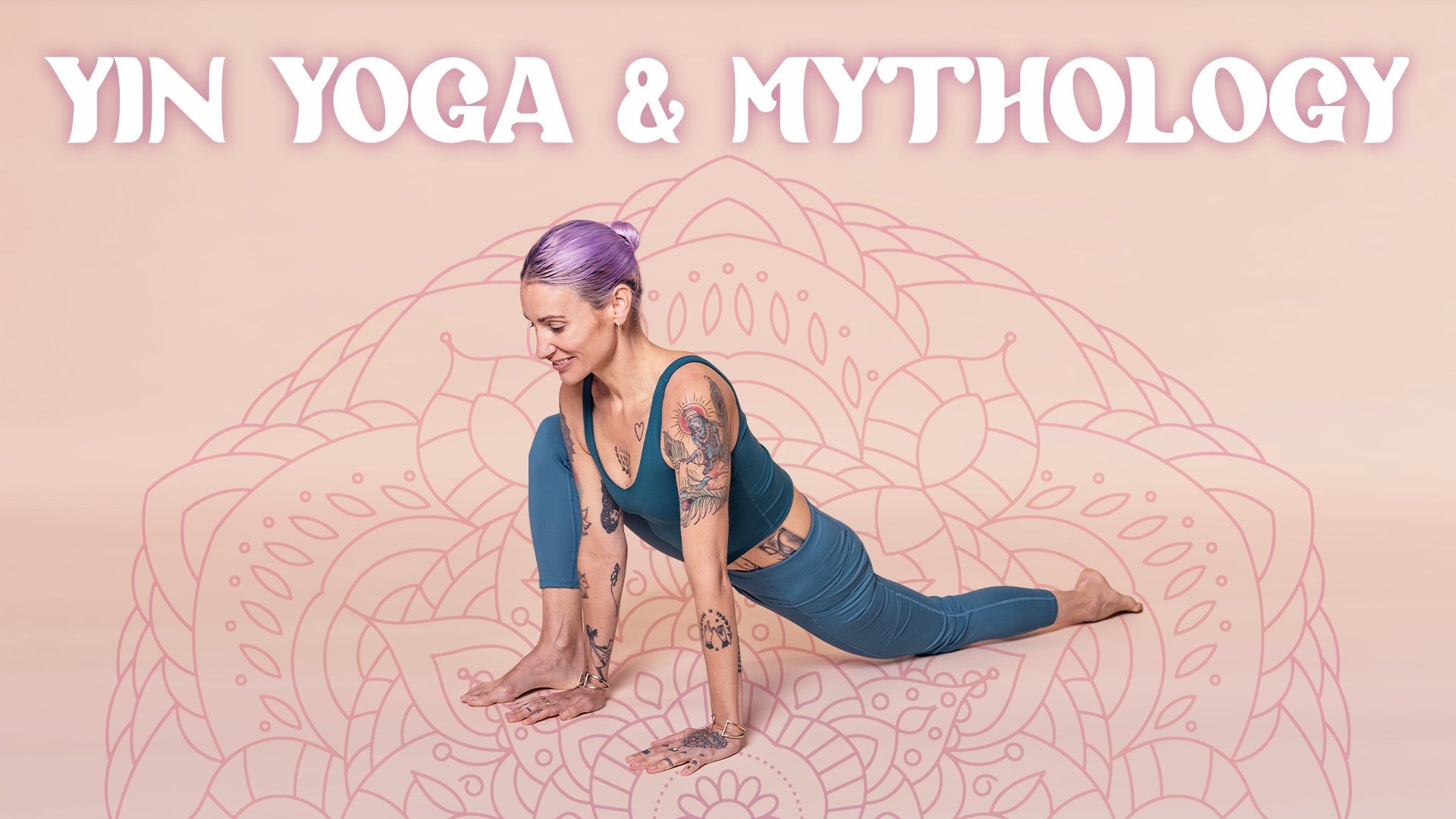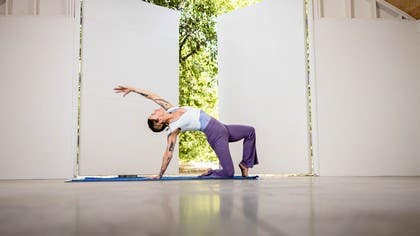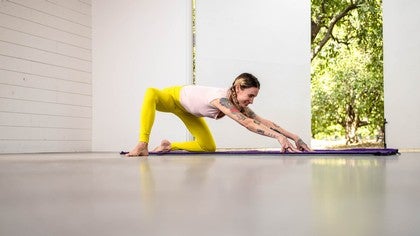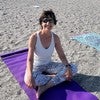Description
About This Video
Transcript
Read Full Transcript
Welcome, let's begin sitting today and you can sit like I am cross-legged if that feels good for you, otherwise any other way that feels comfortable you can sit on a blanket. And when you sit, just taking a moment to kind of snuggle your bones into the ground, to feel yourself on the earth, and to feel the texture of your breath. As you feel the breath come in, notice its temperature, you might follow it with your mind's eye, notice where it goes. If it feels good to you, you could even close your eyes or let them close about halfway so that we start to slow down what's coming in through our field of view. And when we slow that down, perhaps you might feel more in your other senses, noticing the texture of the clothes on your skin or the mat underneath you, noticing any sounds around you, any scent in the air, and then feeling deeper into your body, feeling into your tissues, your muscles, your blood, your bones.
Can you imagine your bones listening inside your body? If your bones were listening, what would they hear? If you could know what your blood was feeling right now, what would it be feeling? If your heart was listening, what is it listening to? We're going to take a deep dive into our senses today, and you'll hear a great story about someone who went through a whole lot of difficulty and created something completely beautiful.
So we'll start lying down. We're going to lie down on our backs, all stretched out, and you're going to pretend like you're in second grade again, and we're going to do log rolls. And so when you lie down, you can stretch your legs out really long, and your arms can reach way up over your head, really wiggling yourself into the ground so that you feel a deep connection with the earth underneath you. And as we begin to roll, imagine that your body is tasting the earth as you roll from side to side, imagine your skin drinking in the ground, all the way through the skin, the muscles into your bones, as if your bones could taste and smell and feel the earth underneath you, pressing your skin into the ground so that you feel every little nuance of sensation, and you might be keeping your eyes closed so that you're feeling, you're listening, you're tasting with your body, just thinking about all different senses coming alive here. Another moment or two, and if you feel like you want to roll further, I'm just rolling side to side.
You could roll across your whole living room if you wanted to, and then come back, and eventually we will come all the way back. You can lie out flat on the ground one more time, take a deep breath in, as you exhale just empty your body into the earth, let every muscle release from every bone, feel the back of your body heavy on the ground, the front of your body soft, bright, light, effervescent. And then we'll come up to sit, so any way that you want to come up, I'm going to bend my knees, tuck my hands underneath them and give a little rock up, you might roll over to the side and press your way up, you come up to sit and bring your hands behind you and your feet in front of you, my feet are about as wide as the mat, and then we're going to windshield wiper the legs from side to side. So ever since I was a little kid, I've always loved really sad music, and like I think I was the only 10 year old who was obsessed with Leonard Cohen. And you know, there's something so beautiful about it.
I think from the very beginning, I had this feeling of like, oh, you too, right? There's something about a sad song that you feel like the musician is saying something to you like, hey, that thing you felt, I felt it too, right? And it creates a feeling not really of sadness. It's like a mixture, a beautiful mixture of sadness and joy, because you feel really connected to anyone who's ever felt like that, and come down onto your elbows here and keep going, letting your knees rock side to side. And so they did this study at the University of Michigan, where they had people talk about their favorite songs, and we'll keep going all the way down onto the back now, and as you come onto your back and keep dropping your knees side to side, you might reach your arms overhead, maybe hook your thumbs or clasp your elbows, and just continue letting your knees rock from side to side until they fall over to the right side.
And when they drop to the right side, you can let them stay right there. Take a breath in as you exhale, just gently re-relaxing the whole body. And then one more step here, if you want to take it, is you could take your right foot and hook it over the outside of your left knee, give a little more weight to the legs like that, and then see if that feels okay. If it does, you stay. If it doesn't, take it off and go back to where we were one step before.
And once you find your place to settle in, take a deep breath in as you exhale, let your bones empty, let the dust settle, let everything get a little quieter again. So they did this study at University of Michigan, they asked people about their favorite songs, and then they asked people how many times they listened to this particular song, and they looked at their playlists and how many times they listened, and people who picked a happy song as their favorite listened to it on average about 175 times. People who picked a sad song, it was over 800 times. You can come back through center, shake it off for a moment, we're going to stay on our backs here and come into a half ankle to knee on our backs, so bringing your arms down by your side again, you can hook your right ankle over your left knee, and then gather your legs in towards your chest. I'm going to take my right hand between the legs here in that little triangle and clasp behind the left thigh, if that feels good you stay there, otherwise you could take your hands around the front of your left shin, and then just like we did before, you're coming into the shape and then gently re-relaxing everything, letting everything settle and move in the direction of the earth.
So there's something about the power of this music that really touches us in a deep place. So if you like to wiggle here, you can always rock and snuggle a little bit, otherwise you can take time and find your way into a really quiet pose here, settling into the suggestion of stillness. So they did another experiment, not at University of Michigan somewhere else, where they looked at all these famous composers like Mozart and Liszt, and they analyzed all of their letters and their journals, and what they found was that when these musicians were writing things to their friends about pain or tragedy, when they were going through a lot of difficulty, this is when they were creating their most memorable, incredible pieces of music. So I want to share a story with you about Beethoven and Beethoven's most famous symphony of all time, The Ode to Joy. And Beethoven had quite a tragic life.
He was very ill for most of his life. They thought that he had chronic lead poisoning, that's the thought now, but he had constant headaches, and beyond that, he just had a really hard time in general, especially later in his life. The women that he loved didn't love him back, and his nephew came to live with him, and they had a really stormy relationship. This really in general, things were not working out well for Beethoven, and then on top of it all, he began to lose his hearing. So I'll tell you the rest of the story after we come out of this shape, you can let go of your legs here for a moment.
Just drop everything on the ground and just feel, just feel your body on the earth, feel any vibrations, any buzzing, the hum of your aliveness, the music of your body. And then we're going to do all of that one more time, the legs on the other side, but we'll start from this rolling around. So as we roll this time, I really invite you to have fun with it. And whatever wants to emerge, whatever longing for movement is in your bones, in your tissues, in your blood, just let it happen. And so you can start rolling over to your side, and who knows what might happen?
You could come into a little back bend, perhaps a sphinx, as you roll back, it might turn into some kind of a twist. They don't have to be poses, it could be anything that feels good. Still playing with this idea of using all of our senses in new ways, you know, that we can really enjoy every little sensation, every scent, every sound, every bit of texture, anything truly that wants to happen. Just playing using our body as a canvas and being creative here. I'm doing this a couple more times and then eventually you can land on your back, take a moment and rest, feel what you've stirred up in your practice already.
And then we'll come up to sitting. So any way you get there is good rolling to your side or tucking your knees into your chest and rocking up is great too. Hands behind you. I have my fingers pointed towards my hips, but you could point them out to the sides or back or anywhere really. And then we'll start that windshield wiper one more time.
We already did it once, we don't have to do it as much this time, we'll go side to side a few times and then down onto the elbows and continue going side to side with the knees. And then eventually all the way down onto our backs, you can reach your arms overhead if that feels good, clasping elbows or hooking thumbs. And this time as we wash the knees from side to side, we'll let them drop all the way over to the left side and stay. And you can stay just like that, or you can pick up your left foot and hook it over the outside of your right knee and then let yourself empty, inviting every drop of you to move in the direction of the ground, let your skin get soft, your bones get heavy. And I'll finish the story about Beethoven.
So where we were is that Beethoven was just really having some hard times. And in the midst of all of this, losing his hearing, which is, as you can imagine, terrifying for someone who makes music for a living, but he had it in his mind that he had to create a symphony out of this poem, Ode to Joy. He loved the poem so much and it was his passion, his greatest project, his life's mission to turn this poem into a symphony. And he worked on it for almost 30 years. And by the time he finally finished it, his hearing was completely gone.
He could hear pretty much nothing but just muffled sounds. He wasn't in love, all the women left him, his nephew who he lived with, they had this terrible relationship and then the nephew ended up dying. And it just was tragedy all around. But somehow, despite it all, Beethoven finished this piece of music. And when it was time to debut it, they played it on the stage in front of everyone who was anyone.
The orchestra was there, the singers were all there, and Beethoven was on stage with all of the musicians. And as they played, Beethoven was looking like no one else had ever looked on stage. Usually people were very calm and they just conducted and were there kind of normal. Beethoven, because he was trying to get the musicians to play the music like he heard it in his mind's ear. He started making himself really ginormous and swinging his arms and then crouching down really low and just waving around like a wild man.
And truly at this point, almost everyone thought that Beethoven was finished. Before this moment, they thought that he was just so crazy and so sick that he was pretty much finished, right? So he's there on stage and they're playing this music and finally it finishes. So you can go ahead and let go of your legs, undo it, settle for a moment, spread out on the ground. The orchestra finishes playing.
Beethoven doesn't know this because he's not facing the crowd, but the crowd starts to go wild. The crowd is going completely nuts. Go ahead and gather yourself in one more time. We're going to rock up to sit or rock off to the side and come up to sit. As you come up to sit this time, you're going to take a square pose.
And so I'm going to put my right shin on top, stacking ankle over knee and knee over ankle. I got my right ankle underneath my right ankle on top of my left knee, right knee on top of left ankle. And here's where you might want some props. You could tuck a block or a blanket or pillow underneath your top knee. And if this doesn't work for you, you can always do a cross leg as well.
Put your right ankle in front of your left ankle and a cross legged position. If you want to have some blocks or support in front of you, that would be another thing you might like here. And then we're going to empty forward, just dropping the chin, rounding the upper back. You can walk your arms out to wherever they feel like you meet that first edge. And then just leaning into it just enough, finding that magic place between sensation and ease.
If you want to come down to your elbows or put your elbows on blocks, you can. Couple of deep, long out breaths to find that sense of sinking in, settling in, like sand settling to the bottom of a glass of water. So the orchestra is finished playing. Beethoven is facing the orchestra, has no idea what's happening behind him until one of the singers, a young soprano, turns him around and he turns around to see this entire auditorium filled with people weeping. They're weeping, they're reaching their arms up in the air, honoring this incredible man, this music that they just couldn't even believe how profoundly gorgeous it was.
And it was his most triumphant moment. And it came out of so much deep, deep difficulty. He turned his pain into something beautiful and everyone could feel that. They could feel what he went through, they could feel his longing, they could feel his sorrow all mixed in with the joy. And I think that's something we really appreciate as humans, the complexity of our emotions.
What Jack Cornfield also often talks about is our 10,000 joys and 10,000 sorrows, right? That our heart holds so much all the time. Perhaps that's why so many of us find sad music so beautiful, that it points to the whole complexity of our hearts, the complexity of our human experience, that in any one moment, one day, one moment, one breath, we could be feeling 10,000 joys and 10,000 sorrows all at once. Let's really slowly start to roll the spine up as if you're pouring the bones of your spine up into the sky, little by little, drop by drop, arriving at the top, feeling the after pose, the effects of your practice. And then we've had our legs bent quite a bit today, so maybe stretching your legs out would feel good here.
You know, in these in-between moments, you can always do anything you like, but I was liking after that pose to stretch the legs and just shake them out a little bit, doing a little side to side, kind of shaking it off to come back to a neutral place before we go to the other side. So those moments are going to happen, aren't they? Nobody really gets away from it. And every moment there's going to be hardship, there's going to be tragedy, there's going to be pain. So I've got my left leg on top this time, I'm going to come into the same ankle to knee shape, left leg on top, right leg on the bottom, and like before, if you need to, you can do cross legged, or you can put some support under your top knee, or under you as you fold forward.
So going ahead and moving forward, folding to whatever degree feels right for you today, and then letting yourself completely soften, every muscle loosening, every bone sighing as if you could breathe right into your bone marrow, and your bones could exhale. Feeling the weight of your body on the earth, perhaps even delighting in it, delighting in the texture of the ground underneath you, a sense of your weight being held by the planet. So we're going to have these moments in our life, and it's really up to us what we do with them. We can try to push them away, we can try to not feel stuff it down or ignore it, but usually it comes out sideways when we do that. Or we can take those moments, and we can make meaning out of them.
And you don't have to be a conductor, a composer, a great artist to do that, to make meaning out of these moments of pain. A great example of that is after 9-11, when so many people signed up to become firefighters, so many people wanted to become nurses. That's the perfect example of making meaning out of difficulty. So as you bring your mind's eye deeper into your body here, what does it see? Can you imagine your mind seeing, looking around inside your body, the whole landscape, your inner world?
As you look around, do you see any places that are clenched or clamped down or tightened up that don't need to be? As you listen, can you listen to the inside of your body? Can you listen with your mind's ear like Beethoven did? And what do you hear inside your body? And bit by bit, coming back, you can walk your hands back underneath you, start to roll your upper body back up, noticing every little nuance of sensation as you come up, stretching legs out one more time to give them some breathing space, letting your legs rock open and shut.
You can always, you know, more movement or less movement in yin yoga and these in-between moments. It's all welcome. Sometimes I like to just be still after a pose, and sometimes I really need to wiggle around and shake it off, so you can decide for yourself what's best, that when you feel like you've been completely sufficiently cleansed, rinsed of that last shape, we'll rest for a bit. You might rest on your back in traditional Shavasana shape or any other way, if you feel better on your side or your front or with your legs up your wall, you could always do that for yourself as you lie down on your back, taking a few moments to feel into the ground underneath you to feel all parts of you that touch the earth, just like in the beginning to welcome them into the ground to let yourself descend, taking a look around your inner landscape again, looking for anywhere that's resisting anywhere that's clenching or wound up or tightly holding back and just inviting every drop of you, every cell, every drop of fluid to seep down, to move in the direction of the earth, to let muscles fall off of bones and bones sink into the ground. Thank you.
Thank you. As you lie here, take a deep breath in. You might open your mouth and let it sigh out. And perhaps you keep your eyes closed as we make our way slowly back up. With the eyes closed, letting all of your other senses be bright and alive.
Your skin drinking in the breath. Your ears feeling sound. Your whole body alive with sensation. Your bones listening, your blood listening. So if you like, you can stretch out really big and long and just give your whole body tons of breathing room, space on all of your joints. Or you can hug your knees in and give yourself a good squeeze. And then let's roll up. We'll bring it all back full circle coming to where we started in a simple seat.
If you want to let your hands rest on your thighs, you can. Or you might bring one to your heart, one to your center. Letting yourself just feel the way the breath moves and your body responds to it. And feeling into your very human heart with all of its complexities, the 10,000 joys, the 10,000 sorrows. And knowing that we do have this incredible ability to make something profoundly beautiful out of our pain.
And then you can bring your palms together at your heart. Thank you so much for joining me in this practice today.
Yin Yoga and Mythology
Comments
You need to be a subscriber to post a comment.
Please Log In or Create an Account to start your free trial.



















